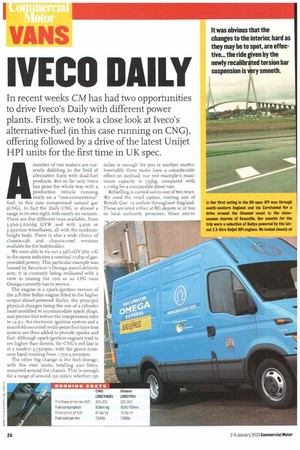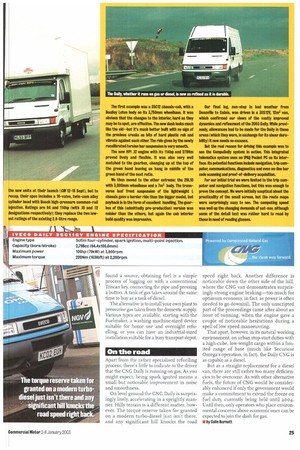IVECO DAILY
Page 24

Page 25

If you've noticed an error in this article please click here to report it so we can fix it.
In recent weeks CM has had two opportunities to drive Iveco's Daily with different power plants. Firstly, we took a dose look at Iveco's alternative-fuel (in this case running on CNG), offering followed by a drive of the latest Unijet HPI units for the first time in UK spec.
Anumber of van makers are currently dabbling in the field of alternative fuels with dual-fuel products. But so far only Iveco has gone the whole way with a production vehicle running solely on a "non-conventional" fuel; in this case compressed natural gas (CNG). in fact the Daily CNG is almost a range in its own right, with nearly 20 variants. There are five different vans available, from 3,5 oo-5,000kg CVW and with 3,300 or 3,950mm wheelbases, all with the mediumheight body. There is also a wide choice of chassis-cab and chassis-cowl versions available for the bodybuilder.
We were able to try out a 35CiiGV (the iiG in the name indicates a nominal ilohp of gasprovided power). This particular example was loaned by Securicor's Omega parcel delivery arm; it is currently being evaluated with a view to joining the Do° or so LPG vans Omega currently has in service.
The engine is a spark-ignition version of the 2.8-litre Sofim engine fitted to the higher output diesel-powered Dailys, the principal physical changes being the use of a cylinder head modified to accommodate spark plugs, and pistons that reduce the compression ratio to i2.2:i. An electronic ignition system and a manifold-mounted multi-point fuel-injection system are then added to provide sparks and fuel. Although spark-ignition engines tend to rev higher than diesels, the CNG's red line is at a modest 3,750rpm, with the green economy band running from 1,75 0-3,o0orpm.
The other big change is the fuel storage, with five steel tanks, totalling 220 litres, mounted around the chassis. This is enough for a range of around 15o miles; whether 150
miles is enough for you is another matter. Inevitably these tanks have a considerable effect on payload; our test example's maximum capacity is 735kg, compared with i,tiokg for a comparable diesel van.
Refuelling is carried out in one of two ways. We used the retail option, visiting one of British Gas' 12 outlets throughout England. These are sited either at BG depots or at bus or local authority premises. Once you've
found a source, obtaining fuel is a simple process of logging on with a conventional Triscan key, connecting the pipe and pressing a button. A tank of gas takes around the same time to buy as a tank of diesel.
The alternative is to install your own plant to pressurise gas taken from the domestic supply. Various types are available, starting with the Fuelmaker, a washing machine-sized device suitable for home use and overnight refuelling, or you can have an industrial-sized installation suitable for a busy transport depot.
On the road
Apart from the rather specialised refuelling process, there's little to indicate to the driver that the CNG Daily is running on gas. As you might expect, being spark ignited means a small but noticeable improvement in noise and smoothness.
On level ground the CNG Daily is surprisingly lively, accelerating in a sprightly manner. Hilly terrain is a different matter, however. The torque reserve taken for granted on a modern turbo-diesel just isn't there, and any significant hill knocks the road speed right back. Another difference is noticeable down the other side of the hill, where the CNG van demonstrates surprisingly strong engine braking—too much for optimum economy, in fact, as power is often needed to go downhill. The only unscripted part of the proceedings came after about an hour of running, when the engine gave a couple of noticeable hesitations during a spell of low speed manoeuvring.
That apart, however, in its natural working environment, on urban stop-start duties with a high-cube, low-weight cargo within a limited range of base (much like Securicor Omega's operation, in fad), the Daily CNG is as capable as a diesel.
But as a straight replacement for a diesel van, there are still rather too many deficiencies to be overcome. As with other alternative fuels, the future of CNG would be considerably enhanced if only the government would make a commitment to extend the freeze on fuel duty, currently being held until 2004. Until then, only operators who place environmental concerns above economic ones can be expected to join the dash for gas.
• by Colin Barnett
































































































































